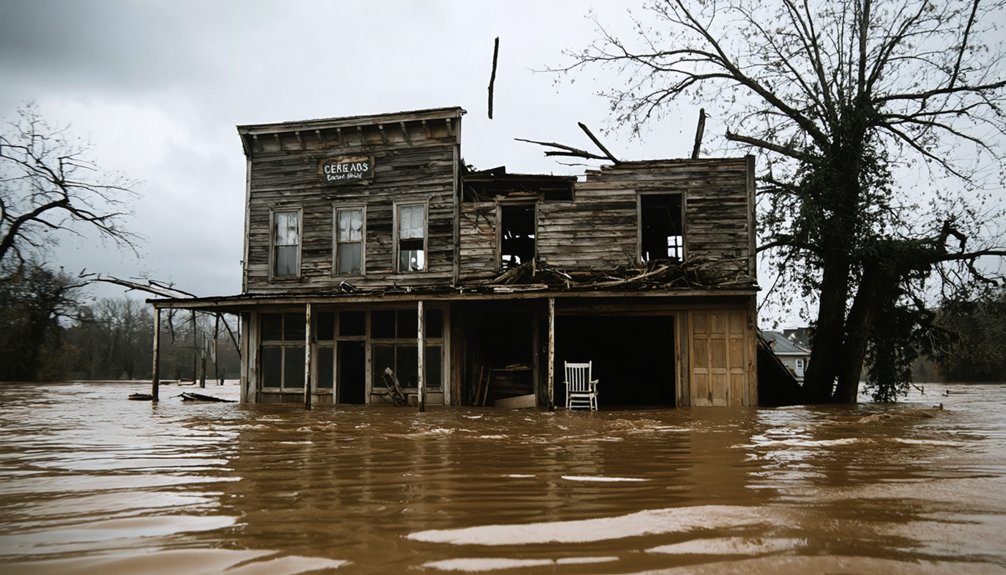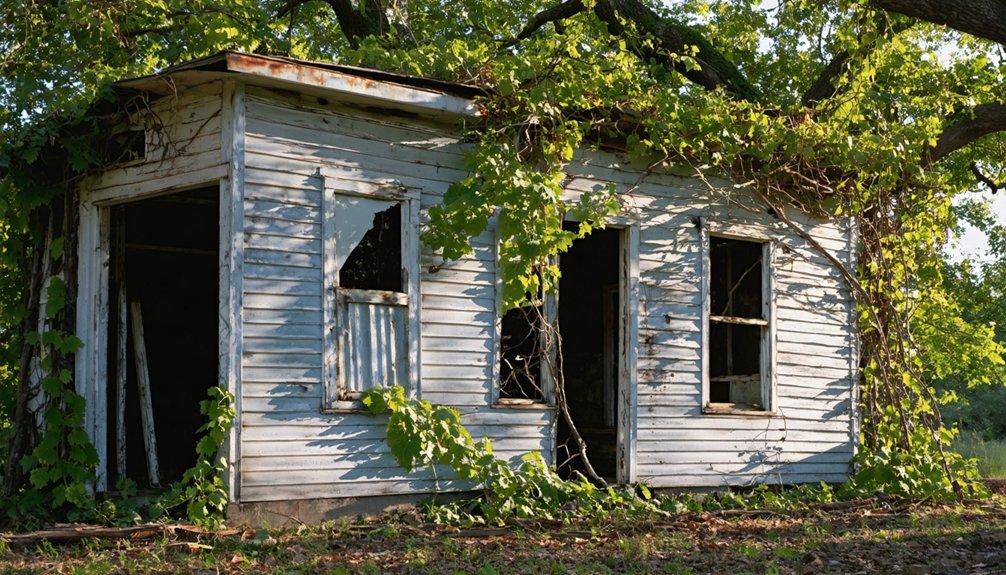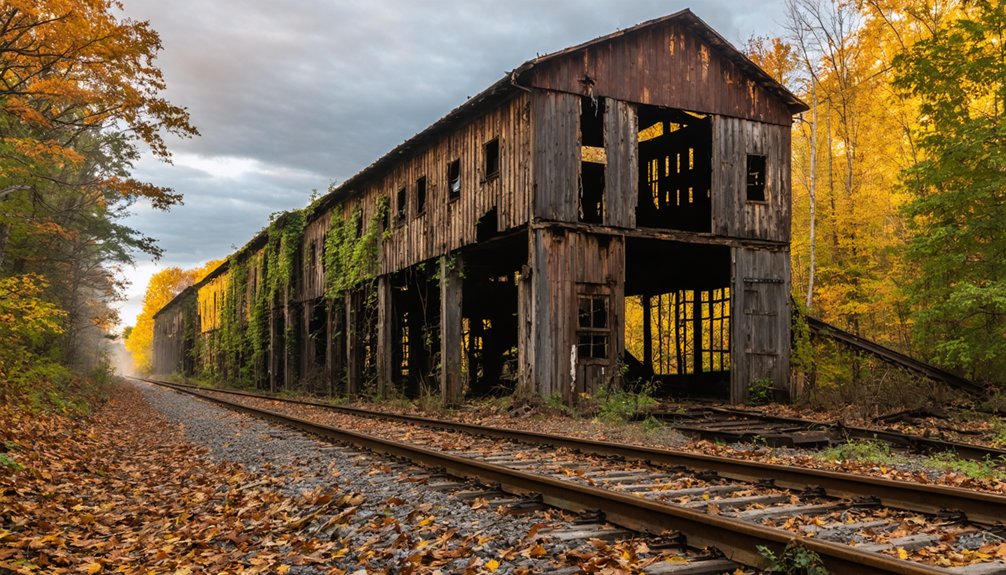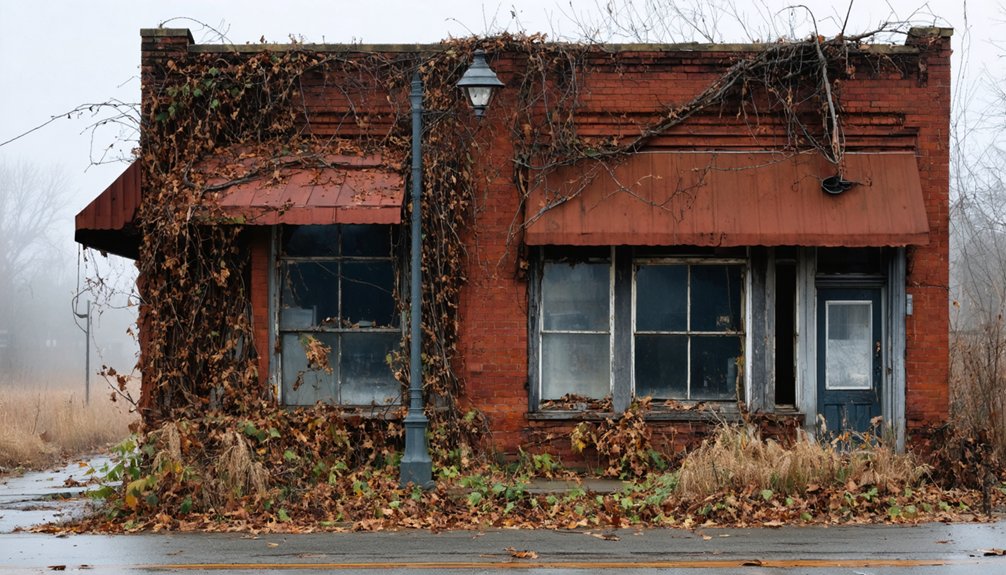You’ll find the ghost town of Dresser along the Wabash River in Vigo County, Indiana. This resilient riverside settlement emerged in the late 1800s, with a post office operating from 1899-1903. The community faced intense poverty, flooding, and social stigma, yet survived through resourceful scavenging and strong neighbor support. While the devastating Great Flood of 1913 contributed to its decline, Dresser’s remarkable story of perseverance still echoes along the Wabash’s banks.
Key Takeaways
- Dresser, Indiana emerged during agricultural expansion near Terre Haute but eventually became abandoned, joining Indiana’s ghost towns due to economic decline.
- The settlement existed briefly around the turn of the 20th century, with its post office operating only from 1899 to 1903.
- Located along the Wabash River, the community faced recurring floods, including the devastating Great Flood of 1913.
- Residents relied heavily on scavenging from nearby dumps and practiced communal survival strategies before the town’s abandonment.
- The town’s legacy is connected to the Dresser family, particularly Paul Dresser, though few physical remnants of the settlement remain.
The Birth of a Forgotten Settlement
While historical records remain sparse about Dresser, Indiana’s exact founding, it’s understood this small settlement emerged in Vigo County during a time when the region’s growth was shaped by agricultural development and industrial expansion.
You’ll find the settlement’s forgotten history intertwined with the legacy of the Dresser family, particularly Paul Dresser, who’d later compose Indiana’s state song.
Local legends suggest the area’s early development paralleled that of neighboring Terre Haute, though on a much smaller scale.
The settlement’s story reflects the broader patterns of Vigo County’s growth, where agricultural landowners and industrial interests shaped the destiny of numerous small communities.
Like many small towns, Dresser suffered a similar fate to ghost towns across Indiana that vanished due to economic shifts and changing settlement patterns.
Like many settlements of its era, Dresser’s origins are rooted in the dynamic period of Indiana’s territorial expansion and the area’s development was influenced by the ongoing French and Indian War that shaped early territorial control.
Life Along the Wabash River
The mighty Wabash River, named from the Miami word *Wah-bah-shik-ki*, shaped daily life in Dresser and its surrounding communities.
You’d find the river’s depths varying dramatically from just over 2 feet to more than 32 feet near its confluence with the Ohio River, creating unique challenges and opportunities for river transportation.
Before roads crisscrossed the landscape, you would’ve seen the Miami tribe utilizing these waters for trade and sustenance, followed by settlers who established crucial shipping routes. The white limestone bottom of the river once gave it remarkable clarity before becoming obscured by mud.
The river’s cultural heritage runs deep – from the beech-maple forests that once lined its banks to Paul Dresser’s famous state song that captured its essence.
The Wabash-Erie Canal transformed the region by connecting local farmers to Eastern markets until railroads made water transport obsolete.
Survival Through Scavenging
You’d find Dresser’s residents gathering daily at the local dump whenever fresh waste arrived from Terre Haute’s restaurants and businesses, searching through the discards for anything edible to sustain their families.
The scavenging wasn’t limited to just food – residents carefully collected items like scrap metal, glass bottles, and rags that could be sold for desperately needed income.
What you couldn’t eat, you’d sell, and what you couldn’t sell, you’d repurpose for shelter or clothing, making sure nothing went to waste in this hardscrabble community.
The town’s isolation intensified after the nearby highway bypassed the area, cutting off vital economic opportunities for residents.
Like many sites across Indiana that became ghost hunting hotspots, the abandoned homes and buildings of Dresser drew curious visitors hoping to experience paranormal activity.
Food From The Dump
Many residents of Dresser relied heavily on scavenging food from local dump sites to survive during the early 1900s, particularly in the wake of devastating floods that disrupted normal food supplies.
You’d find people scouring through restaurant waste and household garbage, searching for salvageable items that became known as “dump cuisine.” Local scavenger networks formed, with residents sharing information about when fresh discards would arrive and which areas yielded the best finds. Early settlers were squatters using scraps from Terot’s dump to build makeshift shelters and survive.
They’d collect slightly spoiled produce, bread products, and meat scraps that could still be cleaned and cooked. While state health officials condemned these practices and stigmatized the community, you’d understand how these resourceful residents had little choice – their proximity to the Wabash River’s floods repeatedly destroyed traditional food sources, making the dumps a vital lifeline.
Making Money From Waste
Surviving in Dresser meant turning trash into treasure during the early 1900s, as residents developed sophisticated scavenging networks to monetize waste materials. You’d find locals scouring the dumps daily, collecting metals, glass, and any salvageable items they could sell to recycling centers or other buyers. This waste economy became the backbone of Dresser’s survival strategy.
The scavenger culture went beyond mere collecting – you’d see people crafting specialized tools to enhance their efficiency and establishing informal trading networks within the community.
Despite health risks and social stigma, these resourceful residents transformed discarded materials into valuable commodities. They’d sell recovered furniture, repair and resell tools, and even gather combustible materials to trade as fuel, creating a circular economy from what others had thrown away.
The Culture of Poverty and Resilience
You’d find the residents of Dresser developing remarkable survival strategies despite their dire poverty, including intricate networks for sharing information about where to find salvageable materials and food from restaurant waste.
Your neighbors would help you learn the best spots to collect metal scraps and rags, which could then be sold to generate minimal income for basic necessities.
Living near the Terre Haute dump provided residents with direct access to discarded items they could repurpose for survival.
Similar to how Jennie M. Conrad asserted her authority through unconventional methods, residents developed their own informal system of leadership to coordinate scavenging efforts.
The community’s resourceful approach to waste management went beyond mere survival, as residents systematically organized their scavenging routes and developed efficient methods for sorting and trading valuable materials they’d recovered.
Daily Survival Strategies
Life in Dresser demanded resourcefulness as residents navigated daily challenges through a complex web of survival strategies.
You’d find people constantly adapting their survival tactics, from scavenging in nearby dumps for usable goods to selling salvaged materials in makeshift markets. When floods struck, you’d see families quickly shift to temporary shelters while maintaining their informal trading networks.
Your economic adaptability meant working multiple irregular jobs, bartering with neighbors, and developing keen eyes for valuable discards.
You’d learn to construct shelters from found materials, forage for food, and share resources within tight-knit community groups. Living in these conditions meant mastering improvised healthcare solutions and passing down essential survival knowledge through generations, creating a resilient culture that prioritized flexibility and mutual support in the face of persistent hardship.
Community Support Networks
While outsiders stigmatized Dresser as a den of thieves and vagrants, the reality within its makeshift borders revealed a tightly-woven support system that defied external prejudices.
You’d find residents sharing scavenged food from restaurant dumpsters, creating informal networks that guaranteed no one went hungry. When the Wabash River flooded, neighbors helped rebuild each other’s homes using salvaged materials, demonstrating remarkable community resilience.
Extended families formed the backbone of daily survival, providing childcare and pooling resources when formal institutions turned their backs. Like the town of Liberty in 1829, health conditions were challenging but residents banded together to provide care for the sick.
These bonds created a self-sustaining ecosystem of mutual aid, where collective knowledge about survival strategies passed freely between households. Despite authorities labeling them a “peril,” Dresser’s inhabitants proved that true strength lies in unity, not isolation.
Resourceful Waste Management
Beneath the surface of Dresser’s tight-knit community bonds lay an intricate system of resourceful waste management that spoke volumes about both necessity and ingenuity.
You’d find residents implementing waste reduction strategies that were far ahead of their time, though born from desperation rather than environmental consciousness.
The community’s sustainable practices emerged from their daily scavenging routines at the local dump, where they’d carefully sort through materials to find food, building supplies, and items to sell.
When floods swept through the Wabash Valley, you’d see these resourceful souls adapting their techniques, salvaging what they could from the rising waters.
Despite the State Board of Health‘s concerns, these survival methods helped residents create a functioning, if unconventional, waste management system that sustained their community through the hardest times.
Health Hazards and Living Conditions
Throughout its troubled history, Taylorville (now Dresser) faced severe public health challenges that stemmed from its proximity to a local dump site where residents scavenged for food and goods.
You’ll find that flooding regularly contaminated the area with sewage and waste, creating devastating health risks for locals. The Indiana State Board of Health even declared the settlement a “Peril” due to these unsanitary conditions.
Living conditions were equally dire. Residents built makeshift homes from scrap materials, leaving them vulnerable to cold, dampness, and disease.
Ramshackle shelters cobbled together from salvaged scraps offered little protection, exposing inhabitants to harsh elements and illness.
They’d often eat discarded restaurant food from dumps, leading to widespread malnutrition. Overcrowding in these unstable dwellings increased the spread of infections, while lack of proper healthcare made recovery difficult.
The combination of poor shelter, inadequate nutrition, and contaminated surroundings created a perfect storm of health hazards.
Natural Disasters and Their Impact

As devastating floods swept through the Wabash Valley in 1913, Dresser faced one of its most severe natural disasters, marking the beginning of a turbulent period that would contribute to its eventual decline.
The town’s lack of disaster preparedness became evident as recurring floods battered the community, testing its resilience beyond breaking point.
You’ll find that these natural disasters left lasting scars on Dresser’s landscape and spirit:
- Homes built from salvaged materials crumbled under the relentless waters
- Essential bridges and roads washed away, cutting off crucial supply routes
- Local businesses shuttered as trade became impossible
- Farmland turned to swamp, destroying agricultural prospects
The community’s resilience wavered as each new flood brought more destruction, eventually forcing many residents to abandon their homes and seek opportunities elsewhere.
Social Stigma and Public Perception
If you’d visited Dresser (formerly Taylorville) in the early 1900s, you’d have encountered a community struggling against harsh media portrayals that labeled it as a haven for criminals and social outcasts.
Local newspapers and health boards branded the area “the Peril of Terot,” focusing on the poverty-stricken residents who built homes from scavenged materials and searched through garbage for survival.
The resulting prejudice led to the community’s isolation, as neighboring towns distanced themselves from Dresser’s residents, creating barriers that prevented economic growth and social integration.
Media Portrayal and Prejudice
The media’s portrayal of Dresser, Indiana, has long shaped its haunting legacy through a lens of prejudice and sensationalism. Persistent media bias painted the town as a breeding ground for crime and moral decay, leading to social exclusion of its residents.
Historical accounts and newspapers intensified this stigma by focusing on the community’s struggles with poverty and scavenging, while ignoring the underlying economic factors that led to these conditions.
When you explore Dresser’s media coverage, you’ll find:
- Sensationalized reports of public health crises and flooding
- Biased descriptions labeling residents as thieves and outcasts
- Ghost stories and supernatural tales that overshadow historical facts
- Negative imagery emphasizing abandonment and deterioration
Community Isolation and Rejection
Beyond media portrayals, Dresser’s isolation stemmed from deeply rooted social stigmas that shaped its tragic destiny.
You’ll find that despite the community’s resilience, Terre Haute’s officials and wider society actively rejected these struggling residents, labeling them as ragpickers and thieves while dismissing their devastating living conditions near the dump.
The Indiana State Board of Health’s designation of Taylorville as a “Peril” only intensified the social exclusion residents faced.
While they endured frequent Wabash River floods and scrounged through garbage for survival, their reputation as unsavory elements overshadowed their human struggles.
This cycle of stigma and isolation meant limited access to resources, political representation, or opportunities for integration, ultimately contributing to Dresser’s decline into a ghost town.
The Great Flood of 1913

Fueled by a stalled high-pressure system near Bermuda and moist Gulf air, devastating storms pummeled Indiana from March 23-26, 1913, releasing what would become known as the Great Flood of 1913.
You’d have witnessed nature’s raw power as rivers swelled beyond their banks, leaving unprecedented destruction in their wake.
- Waters rose so rapidly that rescue boats navigated streets where horses once trotted.
- Families scrambled to upper floors as floodwaters devoured homes below.
- Telephone poles snapped like twigs, silencing communications by March 26.
- Railways vanished under 10 feet of surging water, isolating entire communities.
The flood aftermath brought Indiana to its knees with $20 million in damages.
Community rebuilding efforts began immediately, but for many towns, life would never be the same.
Legacy of a Lost Community
Once known as Taylorville, Dresser’s legacy endures as a stark reminder of Indiana’s complex social history.
You’ll find its cultural memory preserved through local storytelling, though few physical remnants remain of this riverside settlement near Terre Haute. Despite facing intense poverty, flooding, and social stigma, the community demonstrated economic resilience through resourceful survival methods, often constructing homes from salvaged materials and adapting to harsh riverside conditions.
Today, while you won’t find historical markers specifically commemorating Dresser, the town’s story lives on as a reflection of human perseverance along the Wabash River.
The settlement’s struggles with poverty and public health challenges have become important teaching points in regional history, highlighting both the hardships and determination of Indiana’s early riverside communities.
Historical Documentation and Records

While historical records of Dresser remain sparse, you’ll find documentation of this small Warren County settlement in several key sources.
The Warren County Historical Society maintains archival research materials that chronicle the town’s brief but significant period around the turn of the 20th century. The historical significance of Dresser is primarily preserved through these limited but valuable records.
Through carefully preserved records at the Warren County Historical Society, we glimpse Dresser’s fleeting but notable existence at the century’s dawn.
- You can trace the post office’s operation from 1899 to 1903 through official postal records.
- The town’s first postmaster, Harvey Porter Layton, appears in government documentation.
- “A History of Warren County, Indiana” provides context about the settlement’s formation.
- Property and township records confirm the location within Steuben Township boundaries.
Frequently Asked Questions
Were There Any Law Enforcement Efforts to Control Crime in Dresser?
Like shadows in the night, you won’t find concrete records of law enforcement efforts there. While Indiana’s typical crime control systems existed, specific details about policing in this place remain a mystery.
Did Any Residents of Dresser Eventually Move up Into Mainstream Society?
You’ll find most Dresser residents likely moved to larger nearby towns for better opportunities, following typical migration patterns of the era, though specific records of their societal integration challenges don’t exist.
What Happened to the Children Born and Raised in Dresser?
You won’t find clear records tracking these children’s fates. Their childhood experiences likely included scavenging, facing social stigma, and battling harsh conditions. Most community dynamics dissolved after the 1913 flood.
Were There Any Attempts by Charitable Organizations to Help Dresser Residents?
You won’t find much evidence of formal charity outreach to these folks. Despite the severe hardships they faced, records don’t show any organized community support or relief programs helping Dresser’s residents.
Did Dresser Residents Maintain Contact With Relatives Living in Other Communities?
You won’t find concrete proof of family connections in Dresser’s records, but residents likely used basic communication methods like letters through nearby post offices after their own closed in 1903.
References
- https://thisisindiana.angelfire.com/indianahauntings.htm
- https://www.youtube.com/watch?v=45D4dbASJyE
- https://www.youtube.com/watch?v=U2wchT3Yz_Y
- https://www.lowellpl.lib.in.us/s1990may.htm
- http://freepages.rootsweb.com/~gtusa/history/usa/in.htm
- https://www.in.gov/history/state-historical-markers/find-a-marker/birthplace-of-paul-dresser-1859-1906/
- https://en.wikipedia.org/wiki/List_of_ghost_towns_in_Indiana
- https://www.wikiwand.com/en/articles/List_of_ghost_towns_in_Indiana
- http://ingenweb.org/inlawrence/abandoned.htm
- https://greatnews.life/article/three-horrifying-haunts-from-around-the-region-a-catalog-of-northwest-indianas-ghosts/



